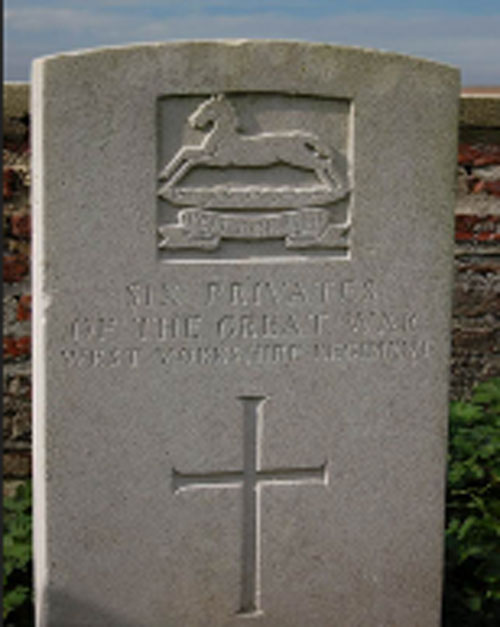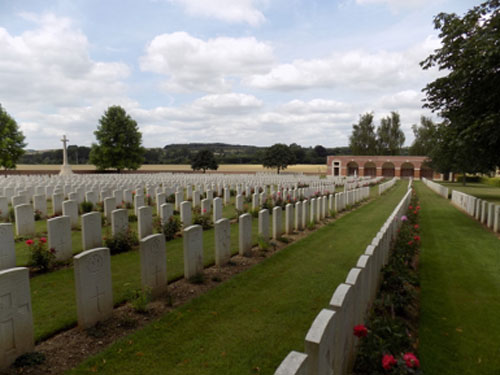
West Yorkshire (Prince of Wales Own) Regiment, 10th (Service) Battalion
John Henry Sheldrake was born in Ossett on 1st January 1893 the second son of eight children born to Suffolk born Arthur Martin Sheldrake (1870-1946) and Sophia Vickers (1868-1919) of Healey, Ossett who married locally in late 1872. John Henry was baptised at South Ossett Christ Church on 5th February 1893.
The Sheldrake family left Suffolk, settled in Ossett in the early 1870’s and in 1881 they lived on Dale Street moving to Healey by 1891 where Arthur Martin worked as a carboniser of rags. In 1901 the family were living at Healey with, at that time, their five children. They lived a door away from the Talbot family, who were to lose a son, Fred, in The Great War. By 1910 the family, including John Henry and six of the couple’s eight surviving children, had moved to Jowett Terrace, High Street, Morley. John Henry was 18 years old and working as a pony driver underground in a coal mine.
By 4th August 1914 Great Britain and much of Europe were pulled into a war which would last 1,566 days, cost 8,528,831 lives and 28,938,073 casualties or missing on both sides.
In spite of his employment status which could have kept John Henry at home he enlisted at Leeds joining the 10th battalion of the West Yorkshire (Prince of Wales Own) Regiment which was formed at York on 3rd September 1914. The battalion became part of the 50th Brigade in the 17th (Northern) Division.
This Division was established by the Northern Command in September 1914, as part of the Army Orders authorising Kitchener’s Second New Army, K2. Early days were somewhat chaotic, the new volunteers having very few trained officers and NCOs to command them, no organised billets or equipment. The units of the Division initially concentrated in the Wareham – Lulworth – Swanage – Wool- Bovington area of Dorset but moved in late May 1915 to Romsey in the Winchester area. After receiving an order that the Division would be retained for home defence (subsequently cancelled), advance parties left for France on 6 July 1915. Main embarkation began on 12 July and units moved to concentrate near St Omer. The Division served on the Western Front for the remainder of the war.
John Henry embarked for France on 13th July 1915 landing at Boulogne on 14th July 1915 and would have spent much of his initial period in trench familiarisation and then holding the front lines in the southern area of the Ypres salient.
In 1916 John Henry would be as well versed as training allowed but nothing could foresee the tragedies on 1st July 1916; the first day of The Battle of The Somme, aka The Battle of Albert.
This is the Regimental Diary of the 10th Battalion West Yorkshire (Prince of Wales Own) Regiment . The date is 1st July 1916 and the words were penned on that day;
At 7.30 a.m. the Battalion took part in the grand assault. The objective being as in the attached orders. On the right were the 7th Division and on the left the 21st Division (to which John Henry’s 50th Brigade had been attached). The battalion assaulted in 4 lines. 2 lines got through the German position to the 4th line and were cut off, the attack on our left having failed. Casualties were very heavy chiefly caused by machine guns which enfiladed our left flanks and were so deadly that the 3rd and 4th lines failed to get across “No Man’s Land”. 27 officer casualties including two killed and approximately 750 other ranks. The battalion was then withdrawn to Ville.
The 10th battalion West Yorkshires were fighting near Fricourt approximately three miles due east of Albert, and was towards the southern part of front on which the British attacked on the 1st of July 1916. In this area there was early success, with nearby Mametz captured on the first day and Fricourt taken on the 2nd of July. It was the 21st Division which attacked at Fricourt on the 1st of July, and the 10th West Yorkshires of 50th Brigade were heavily involved and suffered very heavily.
The 10th West Yorkshires attacked very near what became the Fricourt Cemetery which is in, what was then, No Man’s Land. The first two companies to attack made good progress, in part at least due to the firing of the mines. The third and fourth companies however, going over a little later were cut down by machine gun fire. It is believed that the casualties suffered by the 10th West Yorkshires were the highest for a single battalion on the first day of the Somme. They were higher even than those of the Newfoundland Regiment near Beaumont Hamel.
The Commanding Officer (Lieutenant-Colonel Dickson), Second-in Command (Major Knott) and the Adjutant (Captain Shann) were all killed, with total casualties of 22 officers and possibly 750 other ranks, although a slightly lower figure of 710 total has also been suggested. Of these, just under 400 were killed, a very high ratio which reflects that those who were not killed outright as they advanced were pinned down in No Man’s Land in clear view of the Germans for the rest of the day.
The cemetery itself consists of four mass graves made shortly after the 1st of July attacks, with a few other graves added later in 1916. There are 210 soldiers buried here altogether, with most being identified soldiers, and the vast majority (159) are men from the 10th West Yorkshires; their horse emblem is seen on many of the headstones.
 Several of the graves have two names on, and where those buried here are not identified by name, often their rank or regiment was known; so headstones may read ‘A Sergeant…’ ‘A Lance Corporal…’ or ‘A Soldier of the Great War’, although in many cases they are also known to be of the West Yorkshire Regiment. One headstone simply records ‘Six Privates of the Great War. West Yorkshire Regiment.’
Several of the graves have two names on, and where those buried here are not identified by name, often their rank or regiment was known; so headstones may read ‘A Sergeant…’ ‘A Lance Corporal…’ or ‘A Soldier of the Great War’, although in many cases they are also known to be of the West Yorkshire Regiment. One headstone simply records ‘Six Privates of the Great War. West Yorkshire Regiment.’
The first day of the Battle of the Somme, in northern France, was the bloodiest day in the history of the British Army and one of the most infamous days of World War One. On 1 July 1916, the British forces suffered 57,470 casualties, including 19,240 fatalities. They gained just threesquare miles of territory.
Private John Henry Sheldrake fought on the 1st July 1916 and died of his wounds two days later on 3rd July 1916. Thirteen Ossett men were killed in action on 1st July 1916; one died of his wounds on 2nd July and, including John Henry, two died on 3rd July.
Private John Henry Sheldrake of the 10th battalion, West Yorkshire Regiment (Prince of Wales Own) died from his wounds on 3rd July 1916 and is remembered with honour at Heilly Station Cemetery, Mericourt-L’Abbe (I.B.23).
 The 36th Casualty Clearing Station was at Heilly from April 1916. It was joined in May by the 38th, and in July by the 2/2nd London, but these hospitals had all moved on by early June 1917. The cemetery was begun in May 1916 and was used by the three medical units until April 1917. From March to May 1918, it was used by Australian units, and in the early autumn for further hospital burials when the 20th Casualty Clearing Station was there briefly in August and September 1918. The last burial was made in May 1919. There are now 2,890 Commonwealth servicemen of the First World War buried or commemorated in this cemetery. Only 12 of the burials are unidentified and special memorials are erected to 21 casualties whose graves in the cemetery could not be exactly located. The cemetery also contains 83 German graves. The burials in this cemetery were carried out under extreme pressure and many of the graves are either too close together to be marked individually, or they contain multiple burials. Some headstones carry as many as three sets of casualty details, and in these cases, regimental badges have had to be omitted. Instead, these badges, 117 in all, have been carved on a cloister wall on the north side of the cemetery.
The 36th Casualty Clearing Station was at Heilly from April 1916. It was joined in May by the 38th, and in July by the 2/2nd London, but these hospitals had all moved on by early June 1917. The cemetery was begun in May 1916 and was used by the three medical units until April 1917. From March to May 1918, it was used by Australian units, and in the early autumn for further hospital burials when the 20th Casualty Clearing Station was there briefly in August and September 1918. The last burial was made in May 1919. There are now 2,890 Commonwealth servicemen of the First World War buried or commemorated in this cemetery. Only 12 of the burials are unidentified and special memorials are erected to 21 casualties whose graves in the cemetery could not be exactly located. The cemetery also contains 83 German graves. The burials in this cemetery were carried out under extreme pressure and many of the graves are either too close together to be marked individually, or they contain multiple burials. Some headstones carry as many as three sets of casualty details, and in these cases, regimental badges have had to be omitted. Instead, these badges, 117 in all, have been carved on a cloister wall on the north side of the cemetery.
John Henry was posthumously awarded the British, Victory and 1914-15 Star service medals and will be remembered at the Ossett War Memorial alongside his brothers and sisters in arms. We know them as The Ossett Fallen.
Research by The Ossett Fallen Team 2023. Biography by Alan Howe.
SOURCES
Commonwealth War Graves Commission
https://www.cwgc.org/find-records/find-war-dead/casualty-details/272489/j-sheldrake/